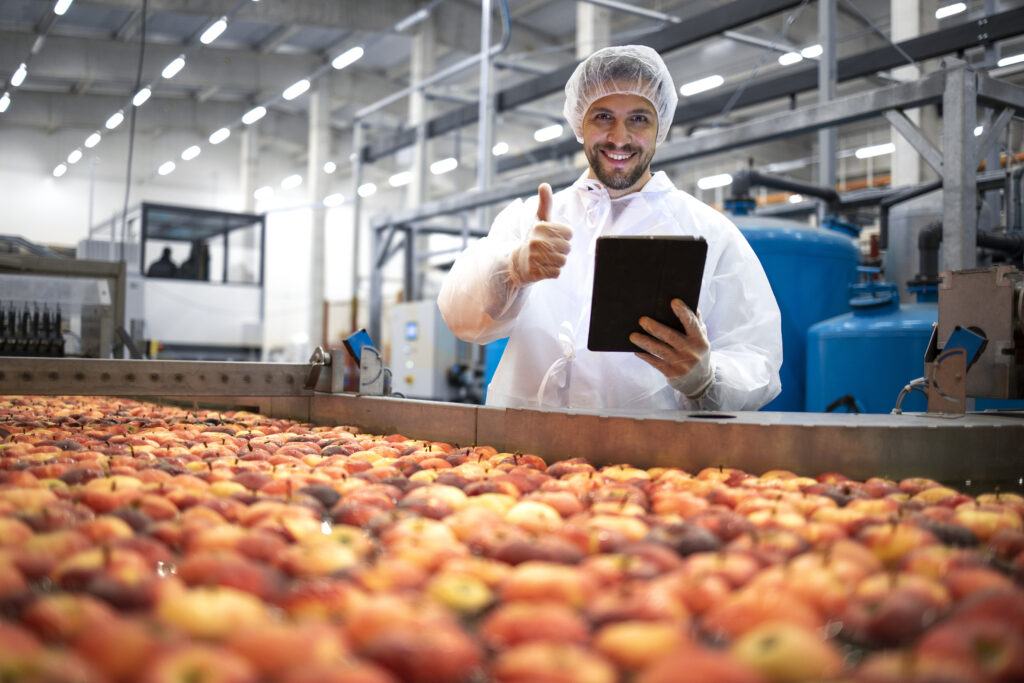We might not be at the point where talking robots are preparing and packaging every aspect of our food products, but we are pretty darn close. Technology has proven to be an indispensable part of increasing productivity and production in the food processing and food packaging sectors. The high demand for fast deliveries and the vast amount of production requires a robust system that is run on efficient and well-structured conveyor systems and production lines.
Automation has enhanced food packaging and processing abilities through applications such as palletizing, depalletizing, packaging, and repacking, bottling, grading and sorting, processing, and logistics.
So what does all of this mean in practical terms? We do more with less.
Let’s take a closer look.
What Can Automation Do in Conveyors and Other Food Processing Applications?
Every aspect of packaging has been made more efficient and streamlined with the use of automation technologies. Automation has improved the tedious and menial tasks that at some point had to be done by hand including:
- The movements of parts and products
- Simple assemblies
- Simple sorting and organizing of products
- Weighing products
- Packaging products
What is Robotic Palletizing?
Palletizing is an important part of some food processing industries. It is not a new process but continues to be improved and necessary for some industries. It refers to the process of organizing products or materials onto pallets. The pallet provides shape. Therefore, it provides the ability for the products to be stacked up. It’s kind of like a lego effect. This improves efficiency in transportation, storage, tracking, and organization.
Collectively a group of products stacked together in pallets is called the unit load.
While palletizing is a widely-used method it is not the most efficient. Modern operations are always seeking solutions and better options on this front. Using pallets as a base for unit loads offers several advantages including:
- Faster loading
- Better organization
- Efficient counting of unit loads
Semi-automated palletization
While manual palletization has been around since the early 1900s, many of today’s food processing centers make use of semi-automated palletization. This form removes the necessity for workers to walk around the pallet.
Automated palletization
A fully automated palletization involves a machine that is programmed to remove items from the end of the conveyor and place them and arrange them in a correct format. Robot palletizers use a type of robot to move and control individual cases.
Common robotic applications are used for products we consume every day. The drive behind various applications can differ between worker safety, efficiency, speed, etc. Automation is seen in:
- Meat processing
- Sorting
- Food handling
- Food packaging
- Specific applications like cake decoration
4 Exciting Robotic Applications for Food Processing
Depending on what kind of item is being handled or the quantity of those items, different automated applications can be used to speed up or improve the process. A couple of exciting technologies help food producers and manufacturers do a couple of things:
- Package raw food. The packaging needed will depend on the type of food item being packaged, but with robotic applications, any shape and size can be accommodated easily.
- De-panning baked goods. Mass-produced baked goods are baked in large pans and it can be difficult and time-consuming to remove them. That’s when robots come in!
- Boxing products or materials. Taking a series of items and placing them into boxes can be a tedious manual task. Employing robotics and automation means that it is sped up and done so uniformly and safely.
- Automatic palletizing. As mentioned above, palletizing is still a very effective way to organize and package materials for transportation and shipping. Using a robotic application to place the items into the pallets is efficient and safe.
Advantages of Using Robotic Applications in Food Processing
Proponents of robotics know that using the technologies has several advantages for manufacturers. Central to these advantages are the benefits and protections that are provided for workers when machines are sent out to do the repetitive and often dangerous tasks.
Here are a couple of the often-cited benefits:
- Robots and automated machines can be cleaned easily, therefore, providing a sterile environment
- Health and safety can also be improved by using automated elements in food processing. Machines can much more easily handle high temperatures or extreme conditions.
- Handling difficult products. Today’s automation tools are very sophisticated and companies have managed to design them for very specific tasks. For example, robotic arms have been created to handle different-sized products and place them in specific packaging.
- Lower energy consumption. When the movement of goods is automated and controlled with machines, energy consumption is kept at a minimum.
Conveyor belts today have improved every aspect of food production, reduced errors, lessened damage to goods, decreased the wastage of goods, and more.
Learn More About Food Processing Automation with Conveyors and Materials Handling
It is an exciting time for the industry as more and more technologies emerge to improve the operations of the food processing industry. Here, at Conveyors and Materials Handling, we specialize in some of the leading technologies of the industries.
If it has to do with conveyor belts, we know all about it! Connect with us today and learn more about how we can help your operations.
